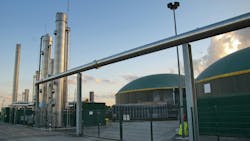Back in 2010, when the San Antonio Water System (SAWS) opened the first sewage treatment facility of its kind in the United States to produce renewable natural gas, or RNG, from organic waste and sell it on the open market, it saw an opportunity to do something positive not only environmentally but financially, too.
SAWS calls it the “recycling trifecta.” The RNG produced at the plant earns the utility about $200,000 in royalties annually. The recycled water produced there is used by the city and by golf courses, parks, and commercial and industrial customers in the area in place of potable water. The plant also processes waste into fertilizer that is marketed locally to improve soil quality. Furthermore, by capturing and refining rather than flaring the methane produced during the wastewater treatment process, the city reduces its greenhouse gas emissions.
Who said waste processing is a dead-end business? With a willingness to shift away from the traditional take-make-dispose linear consumption model, toward more circular and less emission- and resource-intensive approaches to managing waste, wastewater utilities in North America and abroad are proving that wastewater streams can yield valuable revenue streams.
Examples of RNG at wastewater plants in North America
In Virginia, for example, the Western Virginia Water Authority is producing pipeline-quality RNG for the local gas utility via the anaerobic digestion treatment process, earning valuable renewable energy credits in the process. Recognizing the revenue potential in its facilities, the authority rehabilitated and upgraded five anaerobic digesters to increase its RNG output. Meanwhile, the RNG produced at a similar facility operated by the City of Phoenix Water Services Department is generating $1.2 million annually to be shared among the plant’s municipal co-owners, the cities of Glendale, Mesa, Phoenix, Scottsdale, and Tempe.
In Washington State, the city of Tacoma uses some of the RNG produced at municipal wastewater treatment facilities to power a fleet of waste collection trucks, offsetting fuel costs for the city while also eliminating more than 900 tons of greenhouse gas (GHG) emissions per year, the equivalent of taking 170 diesel trucks off the road. The city is using savings from the project to fund capital improvements at the plant. It’s also realizing financial benefits from tax credits and revenue generated by sharing some of the plant’s RNG output with neighboring cities.
The Europena leaders in generating RNG from wastewater
In Europe, the Spanish energy company Cepsa opened a wastewater recycling facility to produce water for the cooling towers at one of its power plants. The result: an overall 25% reduction in water use at the plant. Cepsa also has partnered with local municipalities to use recycled water from urban runoff at its power generation facilities, displacing enough freshwater to serve a town of 35,000 people in a highly water-stressed region. The company also plans to generate hydrogen from recycled water produced at the wastewater processing facility as fuel for industrial and transportation uses.
Meanwhile, the Belgian water utility Farys has developed a water-as-a-service model for neighboring municipalities, providing them with drinking water while managing their water and sewage infrastructure, as well as their wastewater treatment and recycling programs. While the service is not focused on producing energy or secondary materials, it does represent another business model wastewater utilities could explore to generate value for themselves, their partners and their communities.
What monetizing wastewater streams could look like
As analysts at Deloitte concluded in a recent report, the business case for monetizing wastewater is strong.
According to the report, “Renewable natural gas can potentially play a key role in public gas utility decarbonization efforts. It introduces circularity in the production of a fuel that can be used in existing gas pipeline and power plant infrastructure, natural gas vehicles, and thermal applications for commercial, residential, and industrial customers.”
Still, they note, less than one-tenth of U.S. municipal wastewater treatment plants currently capture biogas, and just 2% of them refine their captured biogas into RNG.
“Given the current gap between biogas capture and renewable natural gas production, municipal gas utilities and waste facilities appear to have an opportunity to partner and catalyze the renewable natural gas market for municipal use," the Deloitte report added.
Public entities around the world are increasingly inclined to prioritize investments in infrastructure that also provide opportunities to develop new revenue streams and complementary services. New York City, for example, has begun processing solid and water waste into RNG to produce enough renewable energy to heat 5,200 homes in Brooklyn while cutting GHG emissions by more than 90,000 metric tons annually.
“Nationwide just 29 wastewater plants are working to implement elements of the waste-to-renewable energy strategy,” said Joanna D. Underwood, founder of the nonprofit Energy Vision, commenting on the New York City project. “But there are 16,000 publicly owned systems in the U.S., and many hundreds are large enough to do what New York City has done at its Newtown Creek facility. Surely, the time to get started is now.”
Most of the aforementioned wastewater-to-energy and wastewater-to-secondary products facilities, as well as others similar to them, have sprung from public-private partnerships. Ameresco, a partner in the San Antonio RNG production project, is one such example.
“By partnering with a private entity that can provide risk, technical, and financing expertise, a wastewater utility…can become a self-sustaining energy generator with a relatively low capital investment..[T]he economics of a biogas facility construction and operation can actually be quite favorable," wrote Michael T. Bakas, senior vice president of renewable energy at Ameresco, in a post on the company website.
Why digital monitoring of wastewater is the future
The success of wastewater-to-value projects like these, and the value chains that emerge from them, will also depend heavily on digital infrastructure. That includes the capabilities to monitor and manage operational assets inside the wastewater processing plant, as well as the ability to track material and energy flows as the RNG and secondary materials make their way downstream.
This is necessary to maximize process efficiency and minimize carbon emissions across the lifecycle of these circular products. Artificial intelligence-driven tools, meanwhile, can help in identifying, collecting, managing and reporting emissions data from various sources across these new value chains.
Business networks that enable stakeholders to connect their processes and their systems to share data in real time will also be key to the success of these projects. Ultimately, this free flow of data will lay the groundwork for the “digital passport” era, where stakeholders along the value chain will require a range of information about specific products made from wastewater treatment processes — physical attributes, content (renewable vs. non-renewable), source, carbon footprint, etc. — for reporting, regulatory compliance and other purposes.
With digital capabilities like these in place, wastewater operators will be well positioned to capitalize on opportunities in the emerging circular economy, where waste is a valued commodity.
About the Author

Miquel Carbó
Miquel Carbó is director for Water & Waste Management Services at SAP, where he helps water and waste management organizations build expertise in digital applications and technologies for use in their industries, and helps them identify new use cases and opportunities around the water and wastewater services value chain.

